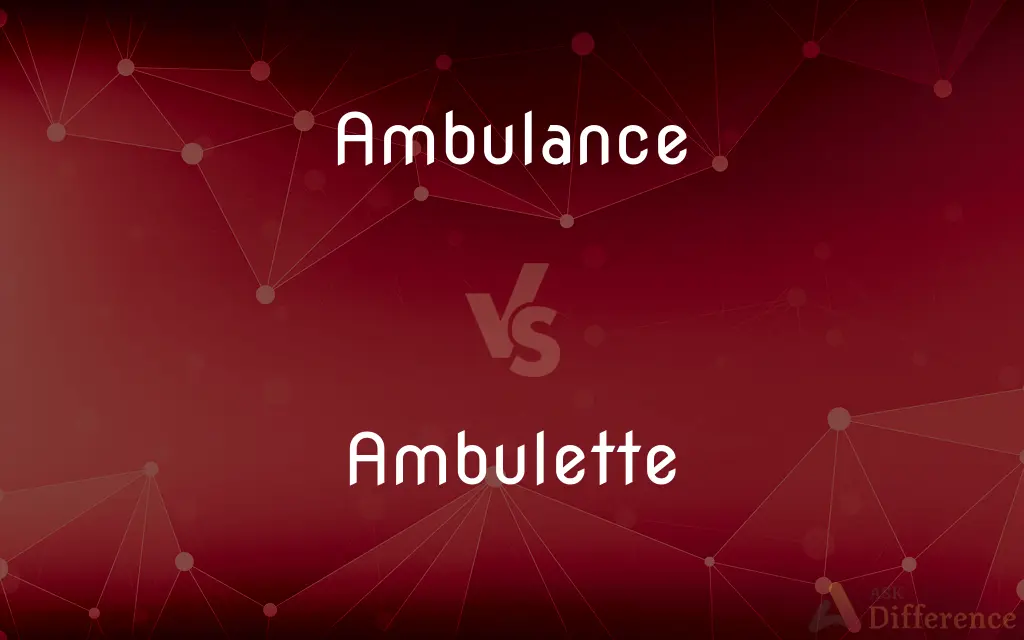Ambulance vs. Ambulette — What's the Difference?
By Maham Liaqat & Urooj Arif — Updated on March 12, 2024
An ambulance is a vehicle equipped for transporting emergency patients, often with life-saving equipment and medical personnel. Ambulette is a non-emergency vehicle, modified for transporting patients who require non-urgent medical care and assistance.

Difference Between Ambulance and Ambulette
Table of Contents
ADVERTISEMENT
Key Differences
Ambulances are critical in emergency medical services, outfitted with advanced medical equipment like defibrillators, oxygen tanks, and stretchers, and staffed by trained medical personnel, including EMTs and paramedics, to provide immediate medical care. Ambulettes, in contrast, cater to non-emergency medical transportation needs. These vehicles are typically modified vans or minibuses equipped with wheelchair lifts, ramps, and secure seating to accommodate patients who might be disabled, elderly, or require transportation to and from medical appointments, such as dialysis, rehabilitation, or routine check-ups, without the need for emergency medical intervention during transit.
The primary function of an ambulance is to offer comprehensive pre-hospital emergency care and rapid transport for critically ill or injured patients, playing a pivotal role in emergency medical systems. Ambulettes provide a vital service for individuals with mobility challenges or special transport needs, ensuring they can access regular healthcare services, enhancing their quality of life and overall well-being.
While ambulances are equipped for high-speed transport and are often granted special traffic privileges, like using sirens and passing through red lights, ambulettes operate more like specialized transit services, focusing on comfort and accessibility rather than speed and emergency intervention.
Both ambulance and ambulette services are essential components of the healthcare system, with ambulances addressing acute, life-threatening conditions and ambulettes ensuring ongoing access to medical care for those with non-urgent, but essential, healthcare needs.
Comparison Chart
Purpose
Emergency medical transport and care
Non-emergency medical transport
ADVERTISEMENT
Equipment
Life-saving medical equipment and tools
Wheelchair lifts, ramps, secure seating
Personnel
Trained medical staff (EMTs, paramedics)
Drivers trained in patient mobility assistance
Patients
Individuals in urgent, life-threatening conditions
Patients needing transport for routine medical care
Operation
High-speed response, emergency interventions
Scheduled, non-urgent transport
Traffic Privileges
Sirens, emergency lights, bypass traffic rules
Regular traffic rules apply
Medical Care
On-board immediate medical care
Basic care, focus on comfort and mobility
Vehicle Type
Modified vans, trucks with medical equipment
Modified vans, minibuses for accessibility
Service Type
Part of emergency medical services
Specialized transit service
Function
Stabilization and rapid transport to healthcare facilities
Access to healthcare facilities without emergency care
Compare with Definitions
Ambulance
A vehicle equipped for emergency medical care and transport.
The ambulance arrived within minutes to provide life-saving treatment.
Ambulette
A non-emergency vehicle for patients requiring medical transport.
The ambulette service ensures her safe transport to dialysis appointments.
Ambulance
Contains equipment like defibrillators and oxygen tanks.
The ambulance was well-equipped to handle cardiac emergencies.
Ambulette
Prioritizes comfort and mobility assistance over medical intervention.
The ambulette provided a comfortable, stress-free ride to the clinic.
Ambulance
Designed for rapid response and transport.
The ambulance used its siren to quickly navigate through traffic.
Ambulette
Equipped with accessibility features like wheelchair lifts.
The ambulette's wheelchair ramp made boarding easy and safe.
Ambulance
Essential for stabilizing and transporting critically ill patients.
The patient was stabilized in the ambulance before hospital arrival.
Ambulette
Used for routine medical visits, not emergency care.
He relies on ambulette services for his weekly physical therapy sessions.
Ambulance
Staffed by professionals like EMTs and paramedics.
Paramedics in the ambulance administered first aid en route to the hospital.
Ambulette
Operates under regular traffic laws, without emergency privileges.
The ambulette service schedules pickups and drop-offs in advance, adhering to traffic rules.
Ambulance
An ambulance is a medically equipped vehicle which transports patients to treatment facilities, such as hospitals. Typically, out-of-hospital medical care is provided to the patient.
Ambulette
A van used to transport patients in non-emergency situations.
Ambulance
A specially equipped vehicle used to transport the sick or injured.
Ambulance
An emergency vehicle designed for transporting seriously ill or injured people to a hospital.
Ambulance
(military) A mobile field hospital.
Ambulance
A prairie wagon.
Ambulance
(transitive) To transport by ambulance.
Ambulance
A field hospital, so organized as to follow an army in its movements, and intended to succor the wounded as soon as possible. Often used adjectively; as, an ambulance wagon; ambulance stretcher; ambulance corps.
Ambulance
A vehicle that takes people to and from hospitals
Common Curiosities
What is the primary difference between an ambulance and an ambulette?
The primary difference is that an ambulance provides emergency medical transport and care, while an ambulette offers non-emergency transport for patients with mobility or special transport needs.
Are ambulances faster than ambulettes?
Yes, ambulances are typically faster due to their role in emergency response, often equipped with sirens and lights to navigate traffic quickly.
Do ambulette drivers need medical training?
Ambulette drivers do not need extensive medical training but are often trained in patient mobility assistance and basic care to ensure safe and comfortable transport.
How do I know if I need an ambulance or an ambulette?
If you are experiencing a medical emergency or a life-threatening situation, you need an ambulance. For scheduled medical appointments or transport without the need for emergency care, an ambulette is appropriate.
What kind of medical equipment is found in an ambulance?
Ambulances carry a wide range of medical equipment, including but not limited to defibrillators, oxygen tanks, stretchers, and various emergency medical supplies.
Can ambulettes provide emergency medical care?
No, ambulettes are not equipped for emergency medical care; they are designed for comfort and accessibility, primarily for patients requiring non-urgent transport.
Can anyone use an ambulette service?
Ambulette services are intended for individuals who require assistance or special accommodations for non-emergency medical transport, such as those with disabilities or mobility issues.
Can ambulances transport patients non-emergently?
While ambulances are primarily for emergencies, they can sometimes transport patients non-emergently, depending on the service and local regulations.
What makes an ambulette suitable for disabled patients?
Ambulettes are designed with features like wheelchair lifts, ramps, and secure seating to accommodate and safely transport disabled patients.
How do ambulances navigate traffic during emergencies?
Ambulances use sirens and emergency lights to alert other drivers, and they are often allowed to bypass standard traffic rules, such as red lights and speed limits, during emergencies.
Are ambulette services covered by insurance?
Coverage for ambulette services varies by insurance policy and provider. Some insurance plans may cover non-emergency medical transportation if deemed medically necessary.
What training do ambulance staff undergo?
Ambulance staff, including EMTs and paramedics, undergo rigorous medical training and certification to provide emergency care and life-saving interventions.
Can ambulettes be used for long-distance transport?
Yes, ambulettes can be used for long-distance non-emergency medical transport, provided the patient's condition is stable and does not require emergency medical care en route.
How do emergency services decide whether to send an ambulance or an ambulette?
The decision is based on the nature of the call and the patient's condition; emergencies require ambulances, while scheduled, non-urgent transports can be served by ambulettes.
Is there a significant cost difference between using an ambulance and an ambulette?
Yes, ambulances, due to their emergency medical equipment and trained personnel, are generally more expensive than ambulette services, which are for non-emergency transport.
Share Your Discovery

Previous Comparison
Leadership vs. Management
Next Comparison
Blackberry vs. BrambleberryAuthor Spotlight
Written by
Maham LiaqatCo-written by
Urooj ArifUrooj is a skilled content writer at Ask Difference, known for her exceptional ability to simplify complex topics into engaging and informative content. With a passion for research and a flair for clear, concise writing, she consistently delivers articles that resonate with our diverse audience.
















































